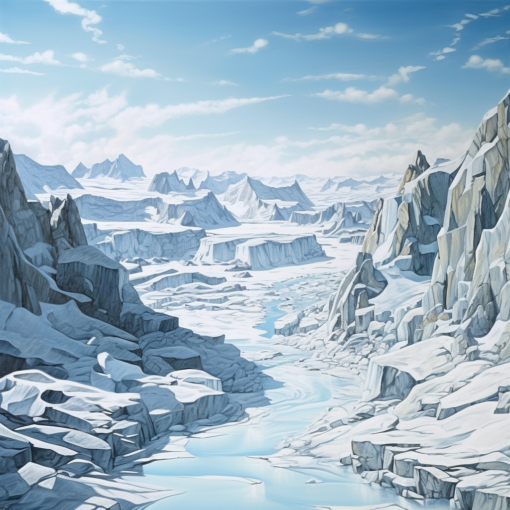Greetings, my dear readers,
As we have traversed both the tangible and intangible together in our mental explorations, we have often focused on the grand and glorious, the dramatic and the seemingly magical. Today, however, I invite you to ponder with me on a less conspicuous yet no less important player in our world’s formation – the very wind that whistles through the trees and caresses your cheek on a breezy day. Yes, indeed, let us dive into the remarkable world of aeolian processes.
Aeolian processes, my dear reader, named after the Greek god of wind, Aeolus, are those lovely activities involving wind’s power in eroding, transporting, and depositing particles, especially in arid or semi-arid environments. Though we may not notice them in our everyday lives, these processes have an enormous and extraordinary impact on shaping our earth’s surface.
Consider, for instance, the majestic sand dunes that rise like golden waves frozen in time in the heart of deserts, from the Sahara to the Gobi. These dunes are not static; they are constantly shifting, morphing, as the wind rearranges their grains of sand in an intricate, never-ending dance. And the patterns – oh! Such mesmerizing patterns the wind weaves onto these dunes, as unique as the most abstract piece of art.
Then there are the hauntingly beautiful yardangs – streamlined, wind-eroded ridges typically found in desert regions. It is wind, with its gritty accomplice, sand, that sculpts these dramatic, often massive, landforms over thousands of years. From afar, they appear like the cresting waves of a tumultuous stone sea frozen in an instant.
Venturing away from arid landscapes, let’s soar to the lofty peaks of snow-covered mountains. Here, the wind sculpts snow into fantastic forms known as sastrugi. These wave-like ridges, hard as concrete, undulate across the surface, aligning themselves with the prevailing winds, their shadows painting an otherworldly picture under the Arctic and Antarctic suns.
As a gentler but no less fascinating effect, consider the wind’s role in seed dispersal, aiding plants and trees to colonize new areas, and thus shaping the very face of our green world.
In the face of aeolian processes, it becomes abundantly clear: the world is a canvas, and the wind, an artist. These silent sculptures, the desert’s shifting sands, the snow’s wave-like ridges, the dispersing seeds – all are testament to the artistry of the wind.
Let us pause then, the next time we feel a gust of wind, to acknowledge its power and its role. Feel its invisible touch, listen to its hushed whispers, and contemplate its patient and persistent artistry in shaping our world, breath by breath, gust by gust.
Yours in ceaseless curiosity,
Percival Q. Higginbottom

Further Reading:
- National Geographic: Aeolian Processes: An informative overview of the concepts of aeolian processes, with insights into how they impact different landscapes around the world.
- Smithsonian Magazine: Wind Sculpts Beautiful Snow Shapes in Antarctica: A deep dive into the wonder of sastrugi formations, the wave-like ridges in snowy regions, crafted by the wind.
- Britannica: Yardangs and their Formation: An insightful look at the formation of yardangs, these stunning, wind-eroded ridges that embody the aeolian artistry.





12 thoughts on “The Whispers of the Winds: The Wonders of Aeolian Processes”
Thank you for your sharing. I am worried that I lack creative ideas. It is your article that makes me full of hope. Thank you. But, I have a question, can you help me?
Thank you for your sharing. I am worried that I lack creative ideas. It is your article that makes me full of hope. Thank you. But, I have a question, can you help me?
Your point of view caught my eye and was very interesting. Thanks. I have a question for you.
Thank you for your sharing. I am worried that I lack creative ideas. It is your article that makes me full of hope. Thank you. But, I have a question, can you help me?
Can you be more specific about the content of your article? After reading it, I still have some doubts. Hope you can help me. https://www.binance.com/da-DK/register?ref=V2H9AFPY
Your article helped me a lot, is there any more related content? Thanks!
Your article helped me a lot, is there any more related content? Thanks!
I don’t think the title of your article matches the content lol. Just kidding, mainly because I had some doubts after reading the article.
Thank you for your sharing. I am worried that I lack creative ideas. It is your article that makes me full of hope. Thank you. But, I have a question, can you help me?
Your point of view caught my eye and was very interesting. Thanks. I have a question for you. https://accounts.binance.com/fr-AF/register-person?ref=UT2YTZSU
Catching the game live on fb88tivi is brilliant. The stream’s usually pretty decent and it’s handy being able to stick a bet on at the same time. Worth bookmarking! Watch live here: fb88tivi
BRDice Casino. Hmm, Dice games? Something to see on this website: brdice cassino